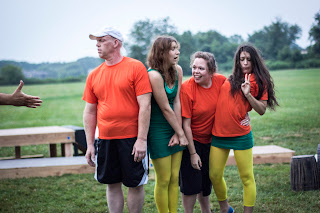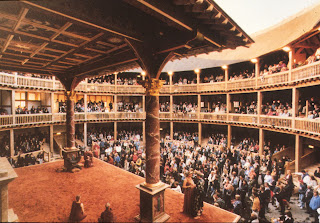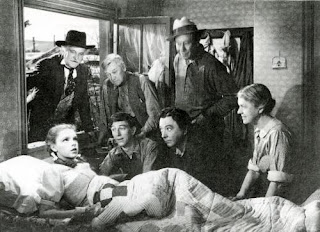With
our final week of rehearsal upon us, the cast relocated permanently from the
classroom to our grassy playing space. Over the last five days we witnessed the
physical world of our play rise majestically behind us, as if by fairy magic.
 |
| Bottom (Maddie Casto) slumbers on our newly-built wagon. |
First
to arrive was the beautiful pageant wagon built by our intrepid director, Josh
Perl.
The
wagon was followed by a series of risers, and on Friday morning, with the help
of Josh, producers Eric Butte and Peter Zablotsky, and actresses Kathryn
Lerner, Maddie Casto, and Kea Trevett (yours truly), our brilliant scenic
designer Peter-Tolin Baker raised the sails on our beautiful set.
 |
| A movable stage or cart employed by traveling theater troupes in the 10th – 16th centuries |
The inspiration
for our nautically-themed backdrop is our production team’s desire to eliminate
artifice—we are setting our Dream in the Hamptons. Entering with our pageant
wagon in tow, we players desire
to make our devices known from the very start of the show, staging a
self-consciously theatrical production that asks the audience to help do the
work of the story-telling by using their imagination to transport them to the
scene.
In
making these choices, we are taking our cue directly from the text: it seems
that Shakespeare’s play is set in a doubly parallel world, for not only does
the fairies’ forest seem a sleeping shadow of the Athenian court, but often
within this green world does Shakespeare remind us of the literal setting of
the play: the theater.
 |
| Bottom's Dream |
By the end of Act IV, the night’s dream is over and morning
has arrived. Bottom speaks of his “rare vision,” one that man has not the words
to describe, Hermia expresses a
sensation of seeing double and Helena likens Demetrius to a jewel, “mine own,
and not mine own.”
By the time we arrive at the strange and wonderful Act V,
we’re out of the forest, but little else is clear, was it a dream? The final
act refuses to provide a straight answer, and the play concludes without confirming
or denying the shadowy world of the fairies as either a real entity or a
manifestation of the overactive imaginations of the mad lovers and Bottom the
dreamer.
 |
| Hippolyta (Clodagh Bowyer) and Theseus (Gerard Doyle) debate. |
At the top of Act V, Theseus and Hippolyta discuss the
previous night’s mysterious events in an exchange that names imagination as the
central player connecting the various “worlds” of the play. You either believe
or you don’t, and while Theseus, the rationalist, does not, claiming
“Imagination bodies forth/ The form of things unknown, the poet’s pen/ Turns
them to shapes and gives to airy nothing / A local habitation and a name,”
Hippolyta is more willing to play along, arguing that all the
lovers’ minds “transfigured so together… grows to something of great constancy." It seems no coincidence that the subject of this conversation
could easily be theater itself.
Perhaps the overarching truth that we are witnessing a work
of dramatic invention dismisses the importance of either confirming the realness
of the fairies or determining the magic in the play as rather a creative
rationalization for certain inexplicable truths of everyday life:
 |
| Oberon (Doyle) reprimands Puck (Ashley Brooke) |
The fickleness of young love spurred by the juice of
Oberon’s magic flower,
The skimming of milk and other trivial household mishaps
accredited to Puck’s mischief,
Aberrations in the weather patterns caused by
marital conflict in the fairy kingdom.
 |
| Mischief makers Puck and Oberon approach a sleeping Demetrius (Kasia Klimiuk). |
And although the potential realness of the fairies’ magic
offers a problematic resolution to the plot- what with the love juice still
governing Demetrius’ affection for Helena- the Mechanical’s play is there to
remind us of the third setting of the Dream, providing, at the very least, a poetic sense of closure...
The action of the plot is done, and the three sets of
lovers, in search of some entertainment to fill the idle space between wedding
ceremony and bedtime, call upon a troupe of players to put on a show.
The players begin with an epilogue that apologizes for any
offence they might cause, and then spend the course of their play trying to
convince their audience that they are not who they appear to be…which seems
like the right job for an actor, but as they are under the impression that
their illusion is too convincing, and
might be taken for reality, they continually stop to explain the theatrical
conventions and mechanics of their play, and take pains to convince their
audience that they are their real selves, which of course they are and they aren’t…
 |
| The Mechanicals rehearse. |
They are Shakespearean actors playing mechanicals playing
mythical characters who are trying to convince their audience(s) that they are
not those mythical characters.
It could be argued that the “rude mechanicals” don’t
understand the rules of the game, and are overcompensating in places where
imagination is meant to do the work. This scene is removed from the green
world, and lacking its magic, a lovers’ drama (with a story premise similar to
that of the Athenian newlyweds) comes across as an unintentional mockery of
itself, and ends in tragedy.
Perhaps the mechanicals’ play is there to represent how
easily the plot of Midsummer could
have gone sour, without the intervention of a little fairy magic.
Another show occurs after the mechanicals exit. As the
lovers retire to bed, the fairies reenter to bless the house. Oberon and
Titania instruct the fairies almost as two directors talking to a troupe of
performers. “Sing and dance it trippingly,” says Oberon, and Titania
follows with “First, rehearse your song by rote /To each word a warbling note."
After the song and dance, Puck remains alone on stage and
apologizes for offending anyone in the (actual) audience, and reassures them
that what appeared on stage were merely visions,
“And this weak and idle theme,
no more yeilding but a dream."
It could be argued that what happens between the lovers
going to bed and the end of the play is a dramatic echo of all that has just
occurred in the fifth act. Oberon, standing in for Theseus, calls for a
performance, Puck, standing in for the mechanicals’ prologue, ends the play,
and the fairy play within a play, with an epilogue apologizing to the audience.
Just as Snug the joiner reassures his onstage audience that
they should not fear the lion, so do the forest spritis make their machinations
known to the real audience. Through this reappearance of the fairies in
self-conscious performance and a self-denying epilogue by Puck, the fairies
give the Athenian lovers the happy ending that a comdey demands. If it was all
a dream, then perhaps the explanation Demetrius gives for his sudden change of
heart is to be believed.
Our goal is that this production will present a dynamic space
that is interchangeably and all at once a real location, a dream landscape and
a stage. It should suggest that just because the fairies are otherworldly
doesn’t mean they don’t exist, and that the faith that animates their kingdom
with life is the same faith that causes the actors to become their parts and
the empty stage to become a forest. It’s the collective belief, the
poetic faith of the audience, not the authenticity of the theatrical illusion,
that allows the drama to occupy that beautiful space between real life and
dreams.









No comments:
Post a Comment